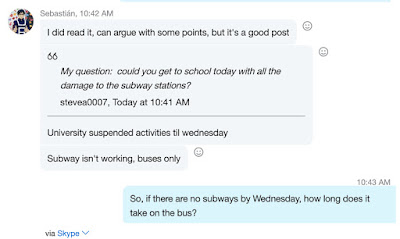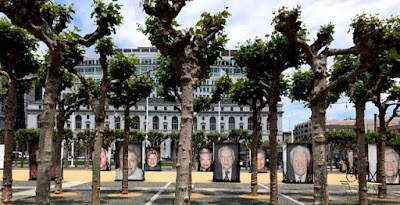The San Francisco Civic Center Plaza had about 80 of the giant portraits. Each had a little sign (if you look closely, you can see it on the right in the middle.)
I'm afraid the title of the post promises a lot more than I can deliver. But the title can at least point to what I'm thinking about as I write this post. I've got too many backed up, unfinished posts. These portraits made me think about the nature of portraits and how they're displayed (in addition to the content of the portraits.) Jurgenson's book is also playing with my understanding of photos in general, and how digital photography and social media change human relationships with photographic images. Here are the two catalysts:
1. Lest We Forget by Luigi Toscano - and installation we saw recently in San Francisco's Civic Center Plaza.
 |
| Click to enlarge and focus better |

And
2. The Social Photo: On Photography And Social Media, a very new book by Nathan Jurgenson that investigates the the meaning of photography in the digital age and how we need to rethink our mental frameworks of photography to understand what's happening.
The notion of portraits has changed over the years.
From the Tate Museum:
"Portraiture is a very old art form going back at least to ancient Egypt, where it flourished from about 5,000 years ago. Before the invention of photography, a painted, sculpted, or drawn portrait was the only way to record the appearance of someone.
But portraits have always been more than just a record. They have been used to show the power, importance, virtue, beauty, wealth, taste, learning or other qualities of the sitter. Portraits have almost always been flattering, and painters who refused to flatter, such as William Hogarth, tended to find their work rejected. A notable exception was Francisco Goya in his apparently bluntly truthful portraits of the Spanish royal family."
Photography changed things dramatically. And cameras on phones changes things even more.
From Nathan Jurgenson. The Social Photo: On Photography and Social Media (Kindle Locations 139-143). Verso.
"Photography is a technology of instability . It stages a play of the real and the simulated, the apparent and the contrived, the creative and the mechanical. And photography is itself always in flux, from plates to film, paper to pixels, to more people carrying more cameras more of the time. These changes affect who makes images, where, why, how often, and for whom. There has been a recent and massive shift in who sees any photograph, and the audience for images that social media promises alters what a photograph is and what it means."
Basically, Jurgenson is arguing that the age of digital photography along with social media presents us with a world of photos that the academic world of photography has essentially ignored because they still use the 'art model' of photography to consider photos. Snapshots don't matter in their eye.
"This is a perspective rooted in art history, one that deals with galleries, museums, and professional work and is tangential to all but a tiny fraction of images made today. The vast majority of photos perform functions distinct from those of documentation or art. The quick selfie reaction, the instantly posted snapshot of nice sunlight on your block, the photo of a burger sent to a friend: these kinds of images are of central importance to photography as it occurs today, but they are not as well conceptualized or understood. These everyday images taken to be shared are examples of what I am calling social photography. Other names include “snapshot photography,” “personal photography,” “domestic photography,” “vernacular photography,” “networked images,” “banal imaging,” or, as Fred Ritchin differentiates in Bending the Frame, an “image” as opposed to a photograph. All these terms are meant to distinguish social images— the overwhelming bulk of photographs being made today— from those weightier images made with that traditional understanding of photography as something more informational, formally artistic, and professional." Nathan Jurgenson. The Social Photo: On Photography and Social Media (Kindle Locations 147-156). Verso.

Her plaque identifies her as
Rachel Goldfarb
(Dokszyce/Poland 1930)
Nazi Armys occupied hometown/
moved to ghetto with the family
Jewish population numbered close to 3000/
Were not sent to concentration camps
but murdered by Nazis/
Less than a dozen survivors/
Only Rachel and her mother survived
from extended family
1942 went into hiding with family
Brother discovered and killed
Survived with her mother with Russia underground
(partisans)
Liberated by Soviets/Experienced widespread and
overt antisemitism in Poland
Left for Italy
1947 migrated to United States
Lest We Forget - Washington 01-21-2018
OLEKSANDR SKLIANSKI
(KIEV/UKRAINE 1937)
"THANKS TO
YEVGENIA BOBOVIK AND VIKTOR BOBOVIK
AS WELL AS THEIR DAUGHTER YELENA
MY BROTHER AND I WERE SAVED
FROM BEING SHOT DEAD IN BABI YAR.
THEY BECAME OUR COMPANIONS
ON THE ROAD TO PEACE."
LEST WE FORGET - KIEV/UKRAINE 26-02015
SUSAN CERNYAK SPATZ
(VIENNA/AUSTRIA 1922)
MAY 1942 ORDERED TO
THE GHETTO THERESIENSTADT
WITH THE MOTHER
JANUARY 1943 DEPORTATION TO
THE CONCENTRATION
CAMP AUSCHWITZ-BERKENAU
JANUARY 1045
DEATH MARCH TO THE CONSTRATION
CAMP RAVENSBRÜCK
SPRING 1945 LIBERATED
BY THE RED ARMY
LEST WE FORGET - HEIDELBERG 18.09.2014

These descriptions are just the briefest references to a period of their lives lived in horror and only the present locations and dates of the photos and the visual images themselves hint at the lives since the end of the war. Though they never escaped the horrors that stayed with them the rest of their lives.
My stepmother could be one of these portraits. She, like Susan Cernyak Spatz, was born in 1922 in the Austro-Hungarian empire (in Bratislava) and also was sent to Theresianstadt. She eventually lived her life out in Southern California. In 2014 she could have posed for one of these photos, but she passed away in 2018. So maybe these portraits resonate with me more. Here she is in 2015 on her 93rd birthday. She didn't have a professional photographer (not sure how he got those little spots in everyone's eyeballs), nor was she allowed to put on some make-up and jewelry. Not sure she would approve of this photo here. But it's one more face for the record. Who knows, she may have known Susan Cernyak Spatz at Theresienstadt.
Luigi Toscano's exhibit seems to recognize that people's relationship with photography is different now. From LEST WE FORGET statement in San Francisco (the
LEST WE FORGET photo above.)
"Instead of exhibiting them in a museum or a gallery, Luigi Toscano always presents the large-scale portraits in public places, such as parks, public squares or on facades, so they are accessible to everyone. In this way, LEST WE FORGET reaches thousands of people regardless of age, origin, language or education. Small information panels, a picture book, and a documentary movie complete the installation."

 |
| SF City Hall in background. |
Nathan Jurgenson wouldn't count these as 'Social Photos":
"My interest here is with a type of photography made ubiquitous by networked, digital sharing, though many of its characteristics can be found in different degrees in pre-social media photography, especially amateur snapshots (Polaroid sharing in particular). For my purposes here, what fundamentally makes a photo a social photo is the degree to which its existence as a stand-alone media object is subordinate." Nathan Jurgenson. The Social Photo: On Photography and Social Media (Kindle Locations 158-160). Verso.
These aren't the instant photos taken on someone's phone and then immediately texted to someone as part of a conversation. Clearly Luigi Toscano thought carefully about each portrait and how to package them and where to display them so that they would be seen and attended to by many people. Looking at these giant face images in person, faces almost as large as the viewer, has a big impact. The holocaust survivors are almost gone. I suspect many, if not most in the installation, have pass away already.
But there is no shortage of victims today, people being killed and maimed and terrorized by American made weapons as well as those made in Europe and Russia and Israel. They are not that different from the Jews and other victims of Nazi Germany, just in the manner of their suffering. But the Jews of Europe were easy to ignore while they were being slaughtered, just as the people of Yemen, Syria, Iraq, and the refugees from terror in Africa and Central America are easy to ignore today.
As I get to the end here, I realize that this mashup of Luigi Toscano's photos and Nathan Jurgenson's book may be a little forced. And I may post more on Jurgenson's book later. But here's a bit more:
"Photography theory’s long marginalization of amateur snapshots has left a shortfall of reference points for making sense of social photos today. The dichotomies of “amateur vs. professional” and “digital vs. analog” matter less for the social photo than the relations between power, identity, and reality. The fixation on professional and artistic photos comes with conceptual baggage rooted in other fields, much of which should slide to the margins when discussing social photography. The center of conceptual gravity for describing how people communicate with images today." Nathan Jurgenson. The Social Photo: On Photography and Social Media (Kindle Locations 167-171). Verso.
LEST WE FORGET website.
Jurgenson's book website.
































